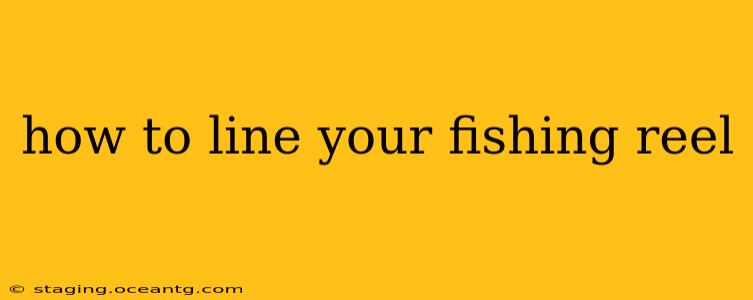Fishing reels are precision instruments, and properly lining them is crucial for optimal performance and a successful fishing trip. A poorly spooled reel can lead to frustrating tangles, backlash, and even lost fish. This guide will walk you through the process step-by-step, covering everything from choosing the right line to achieving the perfect spool.
What Type of Fishing Line Should I Use?
The best fishing line for you depends on your target species, fishing style, and the type of water you're fishing. There are several types to choose from, each with its own advantages and disadvantages:
-
Monofilament: This is a classic choice, offering good strength, flexibility, and knot strength. It's relatively inexpensive and easy to work with, making it a popular choice for beginners. However, it's more susceptible to abrasion and UV damage than other types.
-
Fluorocarbon: This line is nearly invisible underwater, making it ideal for clear water and wary fish. It's also stronger than monofilament for its diameter and more resistant to abrasion. However, it's more expensive and can be more difficult to tie knots with.
-
Braided Line (Superline): This line is incredibly strong for its diameter, allowing you to use thinner lines that are less visible to fish. It casts exceptionally well and offers excellent sensitivity. However, it can be abrasive to your hands and can be cut easily by sharp objects.
What Size Line Should I Use?
Line diameter is measured in pounds test (lb test) which refers to the amount of weight the line can hold before breaking. Choosing the right line strength is vital and depends on the size of the fish you expect to catch and the type of tackle you're using. Consult your rod and reel instructions, and consider the average size of the fish you typically target.
How to Properly Spool Your Fishing Reel: A Step-by-Step Guide
Step 1: Prepare Your Reel
- Clean your reel spool thoroughly. Remove any old line and debris. A clean spool ensures smooth line lay.
Step 2: Attach the Line
- Thread the line through the guides on your rod and tie a reliable knot to the arbor knot. Many anglers prefer the improved clinch knot or palomar knot for their strength and security.
Step 3: Spooling the Reel
- Begin spooling slowly and evenly. Use your thumb to control the tension and prevent the line from piling up unevenly. Aim for a smooth and even layer on the spool. Too much tension can cause the line to bunch, while too little can lead to loose spooling. Practice makes perfect in finding the right tension for your reel.
Step 4: Fill the Spool
- Continue spooling until the spool is almost full, leaving a small space at the top. Overfilling the spool can cause problems.
Step 5: Secure the Line
- After you've filled the spool, use a knot like an arbor knot to secure your line to the spool. Trim any excess.
Step 6: Test the Line
- Pull some line off your reel to test the tension. The line should come off evenly and without resistance.
How Much Line Should I Leave on My Reel?
You should leave enough line on your reel to handle the maximum casting distance you'll encounter. Also, consider adding extra line to account for unexpected situations or larger fish. It’s better to have more than to run out of line.
How Do I Know if My Reel is Spooled Correctly?
A correctly spooled reel will have a smooth, even layer of line across the spool with no gaps or piles. The line should come off the reel smoothly and evenly when you cast or retrieve.
What are Some Common Mistakes to Avoid When Spooling a Fishing Reel?
- Uneven spooling: This is a common issue caused by inconsistent tension on the line.
- Overfilling the spool: This can lead to line tangles and backlash.
- Using the wrong type of line: Use the correct line for your reel and fishing style.
- Not using a backing: Backing (usually thicker line) helps prevent problems caused by thin lines filling the spool, like tangles and difficulty with casting.
- Incorrect knot selection: This can lead to line failure. Always use a strong and reliable knot.
By following these steps and avoiding common mistakes, you can ensure your fishing reel is properly lined, leading to more enjoyable and successful fishing trips. Remember to always consult your reel's instructions for specific recommendations. Happy fishing!
